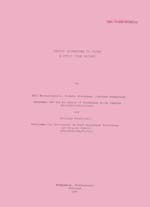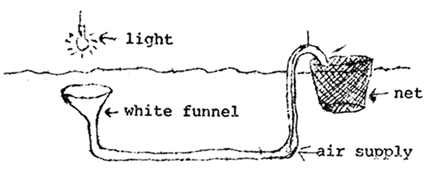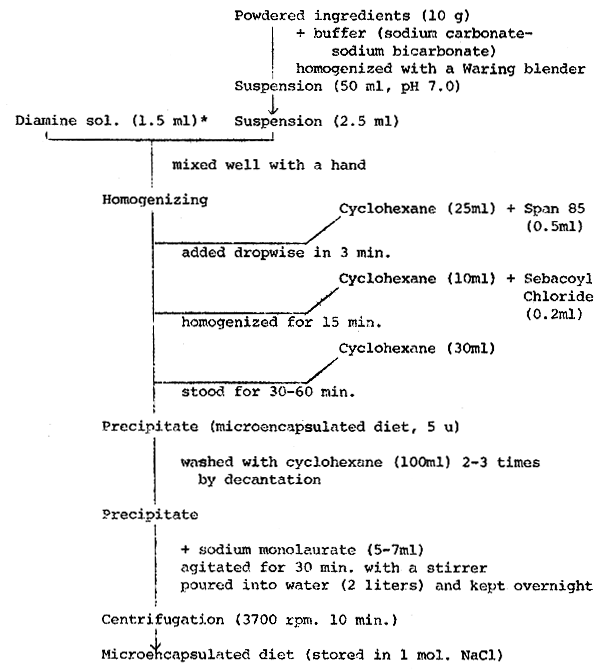
A STUDY TOUR REPORT
 |
THA:75:008:80/WP/21 SHRIMP NUTRITION IN JAPAN A STUDY TOUR REPORT |
by
Mali Boonyaratpalin, Paiboon Vorasayan, Virojana Suksucheep
Programme for the Expansion of Freshwater Prawn Farming (FAO/UNDP/THA/75/008)
and
Krittiya Taechajunta
Programme for Development of Pond Management Techniques
and Disease Control
(FAO/UNDP/THA/75/012)
Bangpagong, Chacheongsao
Thailand
1980
Hyperlinks to non-FAO Internet sites do not imply any official endorsement of or responsibility for the opinions, ideas, data or products presented at these locations, or guarantee the validity of the information provided. The sole purpose of links to non-FAO sites is to indicate further information available on related topics.
This electronic document has been scanned using optical character recognition (OCR) software. FAO declines all responsibility for any discrepancies that may exist between the present document and its original printed version.
SHRIMP NUTRITION IN JAPAN
A STUDY TOUR REPORT
Mali Boonyaratpalina, Paiboon Vorasayanb, Virojana Suksucheepb and Krittiya Taechajuntaa
Shrimps and prawn culture has made significant advances during the last decade in many parts of the world. The incentive for such development was often the profit motive; the most favoured species were those which commanded the highest prices when sold as luxury foods. The demand for prawn in Thailand is way higher than supply plus the market price is 5–10 times higher than fish. Certainly such demand and benefits have provided sufficient stimulus to promote investment in prawn culture by the private sector. In order to help solve the problems which will occur after the rapid growth of prawn and shrimp culture, research on management techniques, disease and feed are necessary. Fundamental nutritional studies are required, prior to the development and commercial production of formulated feed. The nutritional requirements of shrimp have been intensively studied in Japan since 1971, and their results may be useful to our researches on shrimp nutrition and seed production.
The purpose of our visit was therefore to concentrate on visiting establishments where the nutrition of marine and freshwater shrimp is being studied, and to discuss and exchange views on mutual problems and to improve our knowledge of shrimp nutrition and shrimp culture techniques generally.
A list of the places visited and personnel met is given in Appendix I.
In Japan, the shrimp Penaeus japonicus is a delicacy that commands the highest price among fishery products. The price of shrimp is quite different, depending on whether it is alive or not. Usually the price of live cultured shrimp is double that of dead shrimp, although the prices fluctuate seasonally. The price is highest(Baht750 or US$37.50/kg) in April and May because the amount shipped to market (including natural product) is very small.
There are three different type of of shrimp culture in Japan
Extensive
Semi-Intensive
Intensive
Type A is practised in the Seto Inland Sea area. Here shrimp ponds are converted from salt fields, are usually large (1–5 ha), are situated on land and connected with the sea by sluices. In order to supplement dissolved oxygen and encourage the growth of desirable diatoms and dinoflagellates in the ponds, the culturists in this area have to work hard to maintain suitable conditions by regulating the flow of water through sluice gates. There is plenty of natural food in the ponds and, as a result, the conversion ratio from feed to shrimp is the lowest among the various type of shrimp culture and the cost of production is rather low. The stocking density and production can be increased if aeration apparatus and mortor-driven propellers are used.
In type B, in the Amakusa area, the ponds are formed by low stone or concrete dikes with a high netting on top extended out from the shore to enclose an area of shallow sea. The exchange of water is much better than type A but there is less natural food. A greater amount of supplementary feed is therefore needed.
Lastly, there is type C in the Kagoshima area. It is the most advanced system from a technical and management point of view. As its circular tanks, (size 0.1 ha) have double bottoms, the water can pass continuously through a layer of sand which forms the first bottom. In this way, it is possible to supply enough water and oxygen for the shrimps and to get rid of remaining feed and facces. The water exchange rate is 1 time a day for the first month; then the rate will increase as the shrimp grow. The maximum rate of water exchange is about 5 times daily. The production cost of this system is about Baht700 (US$35) per kilogram and the selling price is Baht750 (US$37.50) per kilogram. This type has the highest production per unit area, about 3 kilograms per square meter.
Generally speaking, the growth rate of cultured shrimp is highest when the amino-acid composition of their feed is just the same as that of their own protein. The amino-acid composition of Penaeus japonicus protein is most similar to that of molluses such as shortnecked clam, and to that of squid and some small shrimps, to a lesser degree. In the original artificial shrimp feeds in Japan, squid meal and shortnecked clam were important ingredients but squid and short-necked clam have become very expensive, due to short supply and an increase in their processing for human consumption. Therefore the composition of the artificial feed had to be changed to include cheaper ingredients. The details of its composition are, however, a commercial secret.
Experimental work has shown that peptides, as well as free amino-acid, are far inferior to protein as a nitrogen source in the prawn diet. Addition of glycine to the diet significantly stimulated feed intake. It has been concluded that the optimum dietary protein level for Penaeus japonicus is within the range of 52 to 57%; this level gave good results on the basis of weight gain and feed efficiency. Carbohydrate can spare ⅓ of the protein in the diet.
The nutritive value of monosaecharides, especially glucose, for the prawn, Penaeus japonicus, is inferior to that of the disacharides, sucross and maltose, and polysaecharides such as starch, dextrin and glycogen.
Feeding with diets containing clucose or galactose for 30 days results in high hepatopancreatic glycogen concentration. Also, the sesum glucose level of the prawn increases quickly and remains at a high level for 24 hours. Accordingly, the growth of prawn is inhibited by high dietary glucose level. The optimum disaecharides and polysaecharide level in diet was found to be 20%.
The fatty acid composition of prawn lipids is affected by that of the dietary lipids. Diets containing either pollack residual oil or shortnecked clam elevated 20:5w3 and 22:6w3 level fatty acids and improves both survival and growth as compared with soybean oil diet. Although prawns are able to metabolize parent acids such as linoleie and linolenic acids to w6 and w3 highly polyunsaturated fatty acids (HPUFA) in the same way as demonstrated in fish, the speed of these reactions appears to be too slow to meet the requirements for essential fatty acids and the w3 series of polyunsaturated fatty acid must be provided in the diet. Thus 20:5w3 and/or 20:6w3 possess higher activity as essential fatty acids in the prawn P. japonicus than 18:2w6 and 18:3w3. A mixture of pollack liver oil and soybean oil in a ratio ranging from 3:1 to 1:1 containing approximately 1.2–1.8%w6 and 0.6–1.2%w3 fatty acid in diet, is desirable as a dietary lipid source for prawn. The suitable dietary lipid level appears to be approximately 6%.
Prawns fed on cholesterol-fortified diets attained a remarkably high growth in comparison with those on non-fortified diets, and it was easily concluded that cholesterol should be included in the diet as an indispensable ingredient. The optimum dietary level is 1.4–2.1%.
The addition of glucosamine to the diet did not promote growth of the prawn, and this was especially clear in cases without cholesterol. Therefore glucosamine is by no means an essential material to included in the prawn diet.
Prawns fed on ecdysterone-containing diets, at a concentration of 0.5mg % ecdysterone, casued a marked acceleration of molting. On the survival rate, a definite difference was not observed, but the growth rate was about 50% lower than that of prawn receiving the cedysterone-free diet.
The desirable level of dietary thiamine hydrochloride (Vitamin B1 was found to be approximately 6 mg per 100 g diet on the basis of growth, or approximately 12 mg based on the thiamine content of prawn at the end of the feeding experiment.
Retardation of growth and high mortality occured early on pyridoxine deficient diets. Also, prawns maintained on a diet with a high pyridoxine level exhibited low growth. The favorable level of dietary pyridoxine was found to be approximately 12 mg per 100 g diet on the basis of both the growth and the pyridoxine content of prawn.
The growth and survival of prawn receiving a choline or inositol deficient diet was found to be inferior to those of the complete diet group. The required levels for choline chloride and inositol were estimated to be approximately 60 mg and 200 mg per 100 g of the diet, respectively.
Dietary ascobic acid was found to be effective for the survival, growth and molting of prawn. The requirement for ascobic acid of prarn was about 500–1000 mg per 100 g of dry diet.
Supplements of calcium, magnesium, and iron did not improve the nutritive value of the diet at levels of 2%, 0.3%, and 0.02% respectively. Supplementary iron rather reduced its value. The improved effect of phosphorus supplementation was noticed at a 2% level in the diet. The group fed on the diet supplemented with potassium at a level of 1% showed higher growth and feed efficiency than those of the group fed on the diet without it. The suitable level of trace minerals in the diet was found to be 0.2% while levels over 0.2% resulted in a lower nutritive value than the diet without the supplement
The pH of the diet affects the appetite and growth of prawns. Growth was apparently retarded at dietary pH levels below 6.2 or above 7.8.
Knowledge of the amount, frequency and methods of feed application under various production conditions are essential for farmers so that they can obtain the most efficient feed conversion and maintain good water quality.
Prawn feeds should remain in act in water long enough for prawn to consume them. Prawn feeds should remain stable for at least 3 hrs in water. Wheat gluten is the main binder used in prawn diets in Japan. The effective level is 10%. Sinking pellets and crumble are the forms of feed used for grow out prawns in Japan.
Traditionally, prawn farmers feed once daily, before sunset, six or seven days per week. Feeding Penaeus japonicus more than one time per day does not improve food conversion or growth rate because these prawns bury themselves in the sand during the day time.
Factors affecting the amount of feed prawns will eat are temperature, size, water quality and the amount of feed consumed the previous day. Under most conditions, maximum growth rate of prawn is of primary economic importance; therefore, prawn culturists are interested in feeding prawn as much as they will consume, but without overfeeding. The daily feed allowances presented in Table 1 are based upon feeding relatively high quality pelleted feed, containing about 50% protein.
In the Seto Inland Sea and the Amakura area, natural raw feeds such as shortnecked clams, squid and trash fish are used and the normal dry pellet feeding rate (Table 1) was increased by a factor of 5 to give the amount of raw feed fed per day.
Despite increased production through both fishing and culture, the price of live cultured prawn is usually double that of dead prawns. Therefore dry packing and transported to market alive is very economically important.
The stages in packing are as follows: The harvested prawns are put in a net in a cold water cement tank; the water temeperature being gradually reduced to 12°C within a 3 hour period. At this temperature, prawns are not active and will only move their legs. Their color also become redish. Then 2 kilogram of prawns are packed in each 20 × 40 × 20 cm cardboard box with alternates layer of sawdust. The sawdust is sun dried and stored over night in a -10°C freezer before use as a packing material and insulator. Ice bags or styroform are required in summer packing. By this dry packing procedure prawns will stay alive for 2 days in summer and 7 days in winter.
5.1 Rotifers (Brachionus plicatilis) are the best food for fish and shrimp larvae. The number of larvae which could be produced is limited by the amount of rotifers available. Rotifers are cultured with Chlorella and the Chlorella culture depends on climate which can not be controlled. An alternative feed for rotifers is Baker's yeast (Saecharomyces cerevisiae) which is very good if there is not enough Chlorella available. The amount given is 1 g of yeast/106 cells of rotifer/day. Rotifers cultured with yeast, called yeast rotifers, has been found to cause high mortality in various kind of larval fishes. Prof. T. Watanabe found that yeast rotifer has a lower nutritive value and a lower level of 20:5w3 fatty acid. He solves this problem by two ways:-
yeast rotifers are secondarily cultured with Chlorella, 6–12 hours before feeding to larval fish; then the mortality does not occur.
Baker's yeast is very low in essential fatty acids so he suuplement with 15% cuttle fish liver oil which is high in 20:5w3 and 22:6w3 fatty acid. This yeast is called w-yeast. Rotifers which are cultured by w-yeast are as good as Chlorella rotifers.
Table 1: Feeding schedule for prawns in circular running water ponds in Kagoshima, Japan.
| 22–25°C Feed allowance per day (percent of prawn weight) | Prawn size (g) | 25–30°C Feed allowance per day (percent of prawn weight) |
| 28.6 | 0.01 | 33.3 |
| 24.4 | 0.03 | 27.0 |
| 21.4 | 0.05 | 25.0 |
| 14.3 | 0.1 | 16.7 |
| 10.0 | 0.2 | 11.7 |
| 9.3 | 0.3 | 10.8 |
| 8.6 | 0.4 | 10.0 |
| 8.6 | 0.5 | 10.0 |
| 5.7 | 1.0 | 6.7 |
| 5.3 | 1.5 | 6.2 |
| 4.9 | 2.0 | 5.7 |
| 4.7 | 3.0 | 5.5 |
| 4.7 | 4.0 | 5.4 |
| 4.1 | 5.0 | 4.8 |
| 3.9 | 6.0 | 4.6 |
| 3.4 | 7.0 | 4.0 |
| 3.1 | 8.0 | 3.7 |
| 2.8 | 9.0 | 3.3 |
| 2.4 | 10.0 | 2.8 |
| 2.3 | 11.0 | 2.7 |
| 2.1 | 12.0 | 2.4 |
| 1.9 | 13.0 | 2.2 |
| 1.7 | 14.0 | 2.0 |
| 1.6 | 15.0 | 1.9 |
| 1.6 | 16.0 | 1.9 |
| 1.5 | 17.0 | 1.7 |
| 1.4 | 18.0 | 1.7 |
| 1.4 | 19.0 | 1.7 |
| 1.4 | 20.0 | 1.7 |
| 1.4 | 25.0 | 1.7 |
| 1.4 | 30.0 | 1.7 |
When the larvae grow up to 7 mm, rotifers are to small for them and copepods or Artemia is the live food used for larvae of this size and up. Copepod can be collected from sea at night. Light, white funnels and concentrated net are installed. The collected copepods are concentrated in the net by air lift system

Copepods (Jigriopus japonicus) can be cultured on a mass production scale. The culture media can be any one in the following list:-
Artemia can be classified into two types by fatty acid composition; one contains a high level of 18:3w3, which is the essential fatty acid (EFA) for freshwater fish, and the other is high in 20:5w3, which is one of the EFA's (together with 22:6w3) for marine fish. Therefore Artemia can be roughly classified into two types, the freshwater and the marine type.
Artemia from South America is of the typical freshwater type, being high in 18:3w3 and low in 20:5w3.
Artemia from Lake Saskatchewan, Canada, and those from Tien-tsin of China, were found to be of the marine type.
Artemia eggs of unknown origin sold by Tetra Werke in West Germany and San Francisco were found to be a mixture of the marine and freshwater type, differing from year to year or batch to batch.
Although any type of Artemia may be satisfactory for freshwater fish, judging from their EFA requirement, it is necessary to check the fatty acid composition of Artemia when used as a food for marine fish and shell fish. The dietary value of the freshwater type Artemia nauplii can be effectively improved by feeding them marine Chlorella or w-yeast. When the class of EFA contained in Artemia is unknown, Artemia should be fed to fish together with marine copepods to prevent heavy losses of the fish from shock.
The content of w3 HUFA in the lipid of Monia is significantly affected by the culture media. Moina cultured with yeast are high in monoethylenic fatty acid content and low in w3 HUFA's while those cultured with poultry manure or soybean cake are high in the concentration of 20:5w3, indicating that the former is inferior to the latter as a living feed for fish.
Artificial larval feeds must not only contain all the nutrients necessary in the feed but also the following physical properties:-
Neutral buoyancy or suspension in water for 30–60 minutes.
Size of 5–250 u.
Nutrients must not leach into the water.
Diets has to be attractive to fish.
The feed must be digestable.
Nylon-microcapsulated diets have been formulated and processed by Prof. T. Kanasawa in Kagoshima University. This diet has been shown to be ingested and utilized by Artemia but the result of larvae production experiments using such diets have not been good unless live food is also fed.
The outline of the preparation of nylon microcapsulated diet are shown in Figure 1.
The larval shrimp feeding regime used in Kagoshima is given in Table 2.
Figure 1: Outline of the preparation of microencapsulated diet

* Diamine solution: 0.92g/20 ml, 69 mg/1.5 ml
Table 2: Feed and feeding regime of larvae shrimp in Kagoshima Mariculture Center.
| Stage of shrimp | Artificial feed* | Natural food | |
| Size (μ) | g/time/10 6–3 larvae | ||
| Nauplius | - | - | Phytoplankton |
| Zoea | 147 | 5–10 | Chaetoceros + Rotifer |
| Mysis - P2 | <165 | 15–35 | Brine shrimp + Rotifer |
| P3 - P7 | >165 | 40–70 | Artificial diet only |
| P7 - P20 | 80–160 | " | |
There are three major indiginous species of Macrobrachium, M. formosense, M. japonicus and M. nipponese. In the South Island there are also M. lar and many other species. All of these Macrobrachium have a low growth rate and smaller size than M. rosenbergii, but they can live in cold water which M. rosenbergii can not. Therefore, a cross breeding project is being carried out in the Tokyo University of Fisheries.
Macrobrachium of different species will not copulate, and sperm mass sac transplantation is necessary. Removal of the sperm mass sac immediately after copulation, from one female to a female of a different species which has been molting within the previous 10 hours is successful but no hybrids have been produced yet. The sperm mass is attached to the other female by quick-set adhesive cyano-aclirate (100%). If the receiver is not ready, the sperm mass can be kept in 60% sea water (35 ppt) for 4 days.
Our shrimp culture study tour to Japan was beneficial to us and we did appreciate it very much. We have learned a lot of things we did not know before. It was interesting to see fisheries work in Japan but we would have learnt more in our field of interest if we had had more time for discussions with shrimp nutritionists and shrimp culturists.
We wish to express our sincere appreciation to UNDP, DTEC, the RTG Fisheries Department, the Fisheries Agency of Japan, all the persons whom we met in the institutes mentioned in Appendix I and to Mr. M.B. New for making things possible for us and helping us in many ways. We also like to thank Mr. H. Aoki, who was our interpreter in our trip in Japan, and Dr. Shigeaki Shindo (Deputy Director of SEAFDEC) and Mr. Saiichi Igarashi (First Secretary, Japanese Embassy, Bangkok) who helped to make the study tour possible.
List of Places and Personnel Visited
| Places | Personnel | |
| 1. | Tokyo | |
| - Ministry of Foregn Affairs | Mr. H. Shimada | |
| - Fisheries Agency | Dr. Masaru Fujiya | |
| - International Service Center Cooperation | Mr. T. Kuroda | |
| - Tokyo University of Fisheries | Prof. T. Tomiyama | |
| Prof. Y. Uno | ||
| Prof. Y. Hirasawa | ||
| Prof. T. Watanabe | ||
| - University of Tokyo | Prof. R. Hirano | |
| - Tokai Regional Fisheries Res. Lab. | Dr. M. Takeuchi | |
| 2. | Ise | |
| - National Research Institute of Aquaculture | Dr. H. Sugimoto | |
| Dr. Y. Shimma | ||
| Dr. K. Nose | ||
| Dr. T. Maruyama | ||
| Mr. M. Yano | ||
| Dr. Y. Inui | ||
| Dr. J. Tanaka | ||
| - Kashiko-Tima Station of NRIAg. | Dr. K. Wada | |
| - Founder Hatchery | Mr. M. Nishimura | |
| - Red Sea Bream Farm | Mr. M. Iezaki | |
| 3. | Hiroshima | |
| - Nansei Regional Fisheries Research Laboratory | Dr. Y. Saito | |
| Mr. O Fukuhara | ||
| Mr. K. Negami | ||
| 4. | Yamaguchi | |
| - Yamaguchi Pref. Fisheries Experimental Station | Mr. Y. Inoue | |
| - Yamaguchi Pref. Fish Farming Center | Mr. T. Yatsuyanagi | |
| 5. | Fukuoka | |
| - Kyushu University | Prof. Y. Yone | |
| 6. | Kagoshima | |
| - Kagoshima University | Prof. A. Kanazawa | |
| Prof. H. Hirata | ||
| Ass. Prof. S. Teshima | ||
| - Kagoshima Fisheries Experimental Station | Dr. K. Shigeno | |
| Mr. O. Deshimaru | ||
| Mr. K. Kuroki | ||
| - Mitsui-Norin Shrimp Farm | Mr. H. Mochizuki | |
